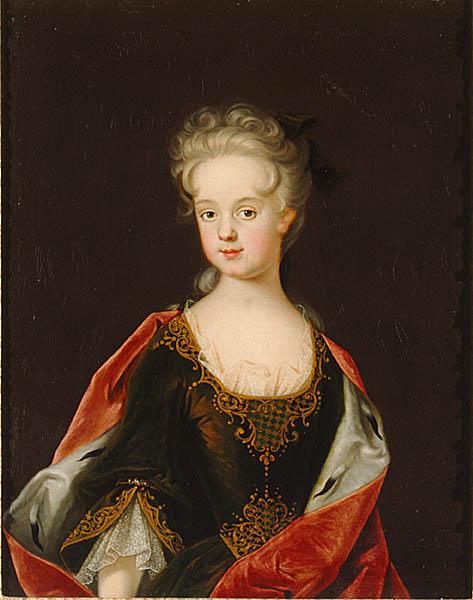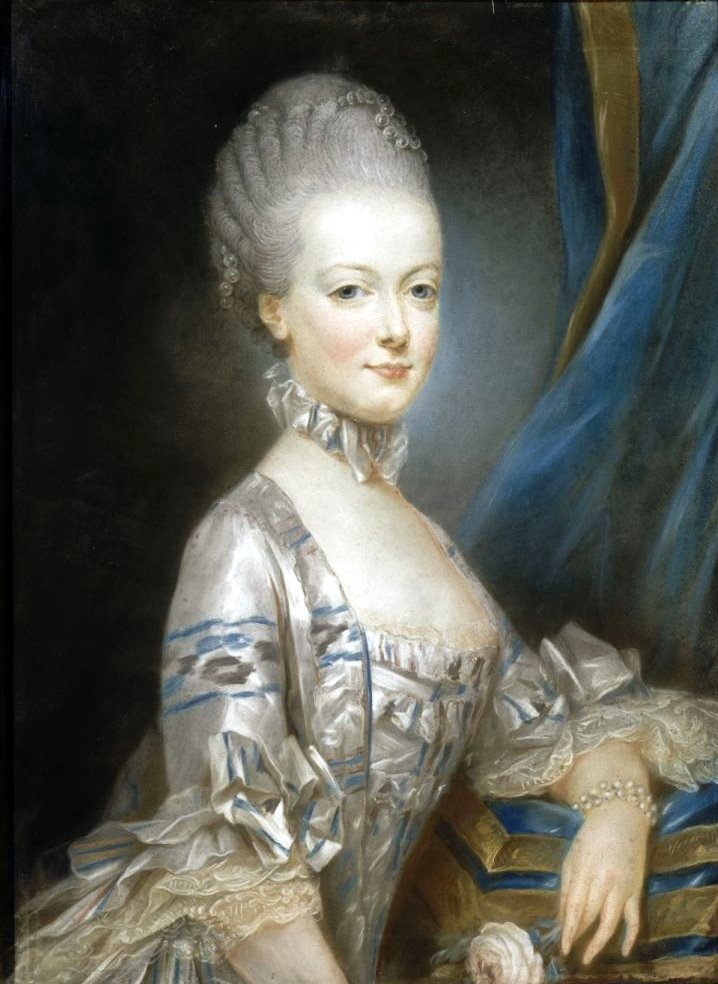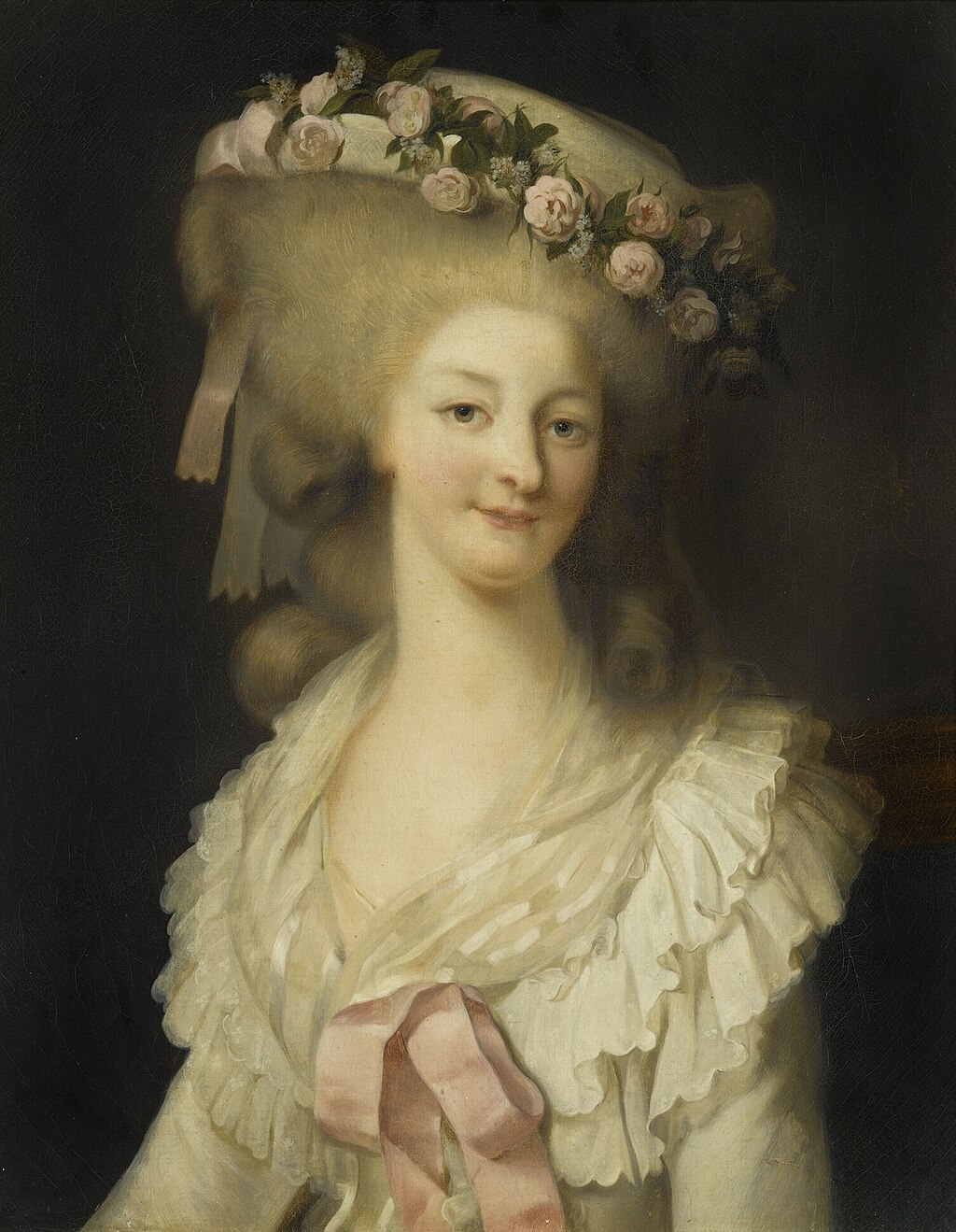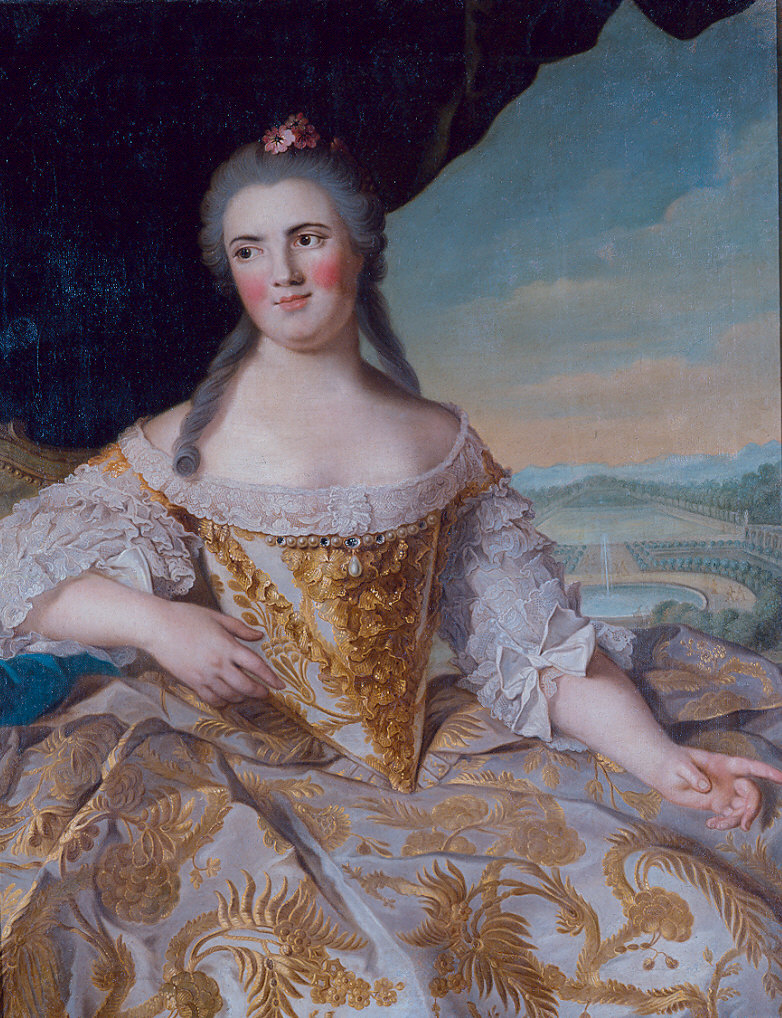The kings and dauphins were not the only ones who were apt to marry foreign princesses. Their cousins, the so-called Princes du Sang (princes of the blood) and the dukes, were equally inclined to fetch their wives from across the border. Some foreigners, like Elizabeth-Charlotte of the Palatinate or Marie Leszczynska of Poland, were bound to make a mark on history due to the postions they held at court. However, there were quite a few more foreign princesses at court who had been married into the finest, French families.
This post looks at which connections were made between the primary families of France and their foreign counterparts - as well as some of the underlying thoughts behind the matches.
Queens & Dauphines
Marie Thérèse
Birth place: Spain
Marie Thérèse and Louis XIV were first-cousins; their parents, Anne of Austria and Philip IV of Spain, were siblings. These two sought to further unite their respective countries by the marriage of their children; due to their close family ties, a papal dispensation was necessary. However, being two of the most powerful, Catholic monarchs in the world, this was not an issue. The two young people were married in 1660. Of their 6 children, just one would live to adulthood - even in an age with rampant infant mortality, this was low and it cannot be ruled out that their children's health were weakened by the inter-marrying of both their parents and grand-parents.
 |
| Marie Thérèse |
Marie Leszczyńska
Birth place: Poland
Marie Leszczyńska was chosen over the Spanish Infanta due to her rather anonymous status on the marriage market. As the daughter of a dispossessed monarch, she could not have expected to have made a particularly good match - let alone such a one as she did. But her father's misfortune happened to be the very thing that tipped the scales in her favour. Having already angered Spain by sending the young Infanta back across the border, France could not afford to further agitate her neighbour. Therefore, it was necessary to find a princess with impeccable pedigree - but from a country that Spain could not object to. Consequently, the choice of Marie Leszsczynska ticked all the boxes: she was Catholic, she was of a child-bearing age, she was the daughter of a king and her family did not pose a threat to Spain.
Unlike her predecessor, Marie Leszczyńska was not closely related to Louis XV. She would turn out to be unusually fertile and would give her husband 10 children over little more than a decade. "Unfortunately" (in the eyes of their times), eight of these were females.
 |
| Marie Leszczyńska as a child |
Marie Antoinette
Birth place: Austria
The choice of an Austrian arch-duchess was an immensely controversial one. Austria and France had clashed on the battlefield numerous times and their recent history was not much better. It was largely due to the alliance between France and Austria, that France was dragged into the Seven Years' War - a war that ended with French defeat at the hands of the British and Prussians. To the public, the new 14-year old dauphine was a symbol of both the defeat and the domestic consequences of it. Over the years, she would become a scapegoat for the dire situation France found herself in.
 |
| The portrait of Marie Antoinette sent to Louis XVI to show him what his fiancée looked like |
Marie Anne Victoire
Birth place: Bavaria
When the Bavarian dauphine arrived in France, she was the first dauphine in 122 years - the last had been Mary, Queen of Scots. The marriage between her and the Grand Dauphin had been a long time in the making. Already in 1668 had the two been betrothed which meant that the bride had been brought up with the prospect of becoming Dauphine of France since she was 8 years old. Genetically, her and Louis were second-cousins.
 |
| Marie Anne Victoire |
Marie Adélaide
Birth place: Savoy
Whereas other matches on this list had been the result of familial considerations, the union between the Duc de Bourgogne and the Princess of Savoy had a far more martial background. Their marriage was a condition written into the Treaty of Turin which stipulated Savoyard support if France went to war - in exchange, the house of Savoy would enjoy French protection and have a daughter of theirs in the French royal family. Marie Adélaide was just 11 years old when she arrived in France. This meant that she was considered too young to marry, so the wedding itself was postponed until the following year - apparently, 12 was an acceptable age to marry...
 |
| Marie Adélaide |
Marie Thérèse Raphaëlle
Birth place: Spain
The marriage between Louis-Ferdinand and the Spanish Infanta was one of two matches brought about to reconcile Spain to France. The two nations had been on very poor terms since the French Prime Minister had sent Mariana Victoria back to Spain and married Louis XV to Marie Leszczynska instead. In an attempt to make up for previous slights, the dauphin was married to Marie Thérèse Raphaëlle and Madame Élisabeth (eldest daughter of Louis XV) was married to the Duke of Parma, a Spanish Infante. The marriage was a very happy one; both bride and groom were quickly on very good terms but their happiness was short-lived. The new dauphine died a year after her marriage following complications after a childbirth.
 |
| Marie Thérèse Raphaëlle |
Marie Josèphe
Birth place: Saxony
The replacement for Marie Thérèse Raphaëlle was found in the Saxon princess, Marie Josèphe. In the War of the Austrian Succession, France and Saxony had been on opposite sides. Therefore, the marriage was thought to be an ideal way to seal a new alliance. It was also considered a great advantage that Saxon princesses were reputed to be extraordinarily fertile - this proved to be quite true of the new dauphine who bore her husband 7 children, of which "just" two died in childhood (quite impressive for the times). The match was not met with unbridled joy, though. Marie Leszczynska's father, Stanislaw Leszczynski, had been dethroned by Marie Josèphe's grand-father, Augustus II. Thus, the queen were initially skeptical about receiving her new daughter-in-law. However, the two were able to mend their differences.
 |
| Marie Josèphe |
Princesses & Duchesses
Henriette, Duchesse d'Orléans
Birth place: England
Henriette had been uprooted from her native England by the Civil War which resulted in her father being executed. Meanwhile, her and her mother lived in France where they were received well by their relations - her mother was by birth a French princess. Her marriage to Philippe d'Orléans tied the family even further together. Henriette had been considered as a bride for Louis XIV but was passed over in favour of the queen-mother's niece, Marie Thérèse. While a marriage to a young man known for his sexual scandals was not ideal on a personal level, it had many advantages. Her rank would be high and she would be provided for - the latter was particularly important as other eligible matches (to the duke of Savoy and grand-duke of Tuscany) had been disrupted due to her being exiled. On the French side, she had become a very attractive match once her brother had been restored to the throne of England.
 |
| Henriette |
Elizabeth-Charlotte of the Palatinate, Duchesse d'Orléans
Birth place: the Palatinate
Elizabeth-Charlotte was recommended as a bride for Philippe by one of his friend, Anne Gonzaga. In one way, she was different from the other ladies on this list: she was a Protestant. Even her predecessor, Henriette, had been brought up as a Catholic despite having been born into the Church of England. Therefore, Elizabeth-Charlotte - reluctantly - converted and - equally reluctantly - married the Duc d'Orléans. Her country of origin was later ravaged by the troops of Louis XIV which naturally caused her great distress.
In the 1770's a series of alliances between France and Savoy resulted in no less than four marriages between the two houses. This would see one French princess go to Savoy and three Savoyard princesses enter France - and Versailles.
 |
| Elizabeth-Charlotte |
Marie Joséphine, Comtesse de Provence
Birth place: Savoy
As the eldest (living) daughter of the Duke of Savoy, Marie Joséphine was a very eligible match. Initially, she had been considered for the position of dauphine but that particular place went to Marie Antoinette instead. One of the greatest supporters of the match was a very unlikely source. Madame Du Barry, the king's mistress, realised that she would never augur favour with the new dauphine and instead sought to place another ally in the royal family. Thus, she heartily supported the match and was even given permission to put together the princess' household.
 |
| Marie Joséphine |
Marie Thérèse, Comtesse d'Artois
Birth place: Savoy
Marie Thérèse joined her sister at the court of Versailles just two years after the latter had departed from Turin. In this, the two were a very fortunate - most princesses never saw their biological families again once they had departed their homeland. As the wife of the youngest royal brother, Marie Thérèse would rank the lowest amongst the three couples that made up the nuclear royal family.
 |
| Marie Thérèse |
Caroline of Hesse-Rheinfels-Rotenburg, Princesse de Condé
Birth place: Hesse
Caroline was the daughter of the Landgrave Ernst-Leopold of Hesse- Rotenburg. She is said to have been included on the list of princesses proposed as potential wives of Louis XV but was allegedly discarded because of her temper. Nevertheless, she was admitted into the rank of princesses of the blood when she was married to Louis Henri de Bourbon-Condé in 1728. Caroline does not appear to have been the first choice of Louis Henri. Instead, he had initially wanted to marry her sister, Philippine, but was discouraged by the French envoy François Blondel. He had been dispatched to Hesse to literally take a look at the princesses and apparently found Philippine to be neither pretty nor slender enough.
 |
| Caroline of Hesse-Rheinfels-Rotenburg |
Auguste of Baden-Baden, Duchesse d'Orléans
Birth place: Bavaria
When Auguste became of age, she was presented with two possible bridegrooms: Alexander Ferdinand of Thurn and Taxis or Louis d'Orléans. Her mother, the regent of Baden-Baden, pushed for the French match as this would secure the principality from further assaults from France - which they had recently endured. Consequently, Auguste was bound to obey although she had personally preferred the German prince. She would not live long at Versailles, dying at the age of 21 after childbirth.
 |
| Auguste |
Marie Thérèse Félicité d'Este, Duchesse de Penthièvre
Birth place: Modena
Due to the unhappy marriage of her parents, Marie Thérèse Félicité grew up in the Palais de Luxembourg in Paris. As such, she might be considered to have been more French than Italian, but according to the laws of the time, she was still the property of her Italian father. If her mother had not been a French princess herself, the match between Marie and the Duc de Penthièvre would likely not have happened. As it was, the marriage took place in 1744. She would also die in childbirth, at the age of 27.
 |
| Marie Thérèse Félicité |
Anne Henriette of Bavaria, Princesse de Condé
Birth place: Paris
Despite being born in Paris, Anne Henriette was half-Bavarian, as her father was the Elector of the Palatinate. Anne was the "original" Madame Palatine at the court of Louis XIV; she was the first cousin of Elizabeth-Charlotte. As a bride, Anne brought with her important connections. Besides her father's Bavarian roots, her aunt was the Queen of Poland and her grandmother was a member of the house of Lorraine. Her marriage to the Prince de Condé was a tragic one. Her husband was very violent and would even beat her in public.
 |
| Anne Henriette |
Marie Caroline de Sobieska, Princesse de Turenne
Birth place: Silesia
Marie Caroline was not an obvious addition to the French court. Having spent her childhood in modern-day Poland, she had been hopelessly in love Michal Kazimierz, a Lithuanian Grandee, but had been refused to marry him by her father. Devastated, she had then wished to retire to a nunnery but that was not to be either. Her uncle, the Holy Roman Emperor, wanted to marry her off and decided upon Frédéric Casimir de La Tour d'Auvergne, Prince de Turenne. In France, she was "foreign" in another manner too: her husband had the rank of Prince Étrangère - or Foreign Prince.
 |
| Marie Caroline |
Marie Maximilienne of Salm-Kyrburg, Duchesse de Thouars
Birth place: Salm-Kyrburg
Little is known about this Duchesse de Thouars, other than she was married to Charles Godefroy de La Trémoille, Duc de Thouars. She was the daughter of Philip Joseph of Salm-Kyrburg which was a smaller, German state in the Holy Roman Empire.
Anne Thérèse of Savoy, Princesse de Soubise
Birth place: Paris
Another Parisian-born foreigner, Anne Thérèse was Savoyard but her parents had been driven from their native country by their incredibly large debts. She would be married to the Prince Étrangère, the Prince de Soubise. She would also die in childbirth, at the age of 27.
 |
| Anne Thérèse |
Victoire of Hesse-Rheinfels-Rotenburg, Princesse de Soubise
Birth place: Hesse
A niece to Caroline of Hesse-Rheinfels-Rotenburg, Victoire was the eldest of daughter of the prince of Hesse-Rotenburg. She married the Prince de Soubise, a member of the house of Rohan which held the title of Prince Étrangère at court. She happened to be the third wife of the Prince de Soubise; the second had been Anne Thérèse of Savoy.
 |
| Victoire |
Marie-Thérèse-Louise of Savoy, Princesse de Lamballe
Birth place: Savoy
This marriage was the first in the Franco-Savoyard alliances and took place in 1767. The match was well-founded both in dynastic terms and personal ones. Both the bride and groom were of a royal line and as such were considered to be equally ranked. Initially, the two seemed to be a happy couple but the marriage was soon disrupted when Louis Alexandre, Prince de Penthièvre had affairs with two actresses which allegedly devastated his young wife. Their union would be very brief. Just a year after their wedding, Louis Alexandre died. The princesse de Lamballe chose to remain unmarried and would shortly after enjoy the perks of being the first close friend of the new dauphine, Marie Antoinette.
 |
| Marie-Thérèse-Louise |
Likewise, the French royal family "exported" numerous princesses to other countries during the Ancien Regime. However, it is interesting to note that just a single one of Louis XV's numerous daughters were married - if the rest had followed suit, this list would undoubtedly be a great deal longer. Amongst the princesses who had to leave France behind were the following:
Marie Louise d'Orléans
Destination: Spain
Marie Louise was the (favourite) daughter of Philippe d'Orléans. Her marriage to Charles II of Spain was arranged by her uncle, Louis XIV, much to her distress. Not only was she in love with her cousin, the Grand Dauphin, but the Spanish king was infamous for his debilitating disabilities caused by an obscene amount of inbreeding. Once she was informed of the arranged marriage, Marie Louise wept continuously and begged both her father and uncle to be let off. However, that was not to be. One particular instance was captured by the memoirs of the time: Louis XIV was again confronted by his teary-eyed niece when he remarked to her that he could not have done more for his own daughter (referring to making her queen of Spain). To this, she allegedly responded: "No, but you could have done more for your niece". The courtiers remarked that she was still crying when her carriage was ordered "To Madrid!". In an eerie twist of fate, she would die in the exact same manner as her mother, Henriette had. At the age of 26 (like her mother) she died following violent spasms in the abdomen which was feared to be from poison.
 |
| Marie Louise |
Anne Marie d'Orléans
Destination: Savoy
France wished to obtain a greater degree of control in the Italian states in the 1680's which led Louis XIV to arrange the marriage between his niece and the Duke of Savoy. She would later become the Queen of Sicily and later of Sardinia, when her husband ascended to those two thrones. As it happens, it was her daughter, Marie Adélaide, who would marry the Duc de Bourgogne. During her marriage, she would bear nine children, although for a while it seemed unlikely. She almost died while giving birth to Marie Adélaide and cannot have been looking forward to the following eight deliveries...
 |
| Anne Marie |
Marie Louise Élisabeth
Destination: Parma
The only daughter of Louis XV to marry, Marie Louise Élisabeth's marriage was the first act in the series of Franco-Spanish marriages to atone for the insult offered to Spain by the rejection of Mariana Victoria. She was 12 years old when she married. Louis XV found it very hard to part with her and even rode the carriage with her for a few miles before leaving her. While her fiancé was a Spanish Infante, he was not likely to inherit the throne. As such, the marriage was considered to be somewhat beneath her, as the eldest daughter of the French king. Even the bride herself admitted that she thought her "destiny less glorious than she had a right to expect".
 |
| Marie Louise Élisabeth |
Marie Clotilde de France
Destination: Sardinia
Clotilde had not originally wished to marry. Instead, she wanted to become a nun but in 1775 a marriage was arranged for her by her brother, Louis XVI. She submitted to the arrangement with good grace and even learnt Italian so that she could better fulfil her duties as Queen of Sardinia. As it happens, her marriage with Charles Emmanuel turned out to be a rather happy one. Clotilde was a large women - even by Bourbon standard - and when she first met her husband, people were eagerly watching him to see how he would take it. Instead of snickering (as some of her own countrymen did) he graciously replied that he only had all the more to love. Their marriage in 1775 was the final union in the Franco-Savoyard alliances of the 1770's.
It is rather ironic to think that the marriage, that Clotilde only entered into reluctantly, probably saved her life. If she had remained in France, then it is likely that she would have been guillotined like her sister and brother.
 |
| Marie Clotilde |

No comments:
Post a Comment